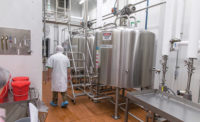
Chief Editor
How does a company founded in the 19th century go about remaking itself in the 21st century? Very carefully.
Louis Graeter started Graeter’s Manufacturing Co. in 1870. For most of the 20th century, the company made ice cream in a converted printing factory on Reading Road in Cincinnati. There, employees hand-filled buckets with ice cream mix, carried them to work stations and poured the mix into spinning vessels called French pots. Other workers stirred the hardening mix with paddles. Then the pints were handpacked and lidded (another manual operation).
In 2007, a fourth generation of Graeters moved into management (see related article on page 95). Richard A. Graeter II is president and CEO. His cousin Bob Graeter is head of manufacturing and Bob’s brother Chip directs the retail operations. As part of a strategic plan, the Graeters’ decided to sell ice cream beyond the Cincinnati region. They built a 28,000-square-foot manufacturing and warehouse facility that opened in 2010. The new plant incorporates automated technology while preserving the most important processes done by hand. The facility includes:
• New pasteurization and mixing tanks
• Overhead piping and pumping of liquid ingredients
• Closed containers during processing
• Two refrigerated receiving bays
• Automatic lidding
• Robotic palletizing
In 2007, Graeter’s sold ice cream to about 33 local Kroger stores. Four years later, the processor is servicing as many as 4,500 grocery stores (and possibly more by year’s end). In that period, the company went from 0 “ship-to” points (meaning other company warehouses or distribution centers that store and/or distribute Graeter’s to grocery stores) to about 33 today. Despite these complexities, Graeter’s still achieved a 99.34% shipping accuracy rate.
For these reasons, the Graeter’s ice cream facility on Regina Graeter Way in Cincinnati is the 2011 Dairy Foods Plant of the Year. Graeter’s runs production shifts from Tuesday to Friday. The plant is capable of producing 1 million gallons of ice cream annually. Current weekly product is about 12,000 gallons (about 625,000 gallons annually). Should there be greater need, management can add shifts, build new work stations or both. The plant was designed for expansion.
Two Cincinnati-based companies, Rodem and Hixson, worked on the new plant. Rodem designed and installed the dairy process system, and Hixson was the architectural and engineering firm.

Graeter’s receives whole milk shipments twice a week at the plant’s two receiving bays. The pasteurized milk and ice cream mix (18% butterfat) arrives in 12 to 15 300-gallon totes. The processor had been supplied by Trauth Dairy of Newport, Ky., until Dean’s closed the facility this summer. Smith Dairy of Ohio supplies ice cream mix in 5-gallon bags to Graeter’s two smaller plants that still produce ice cream for the company’s 29 scoop shops in Ohio.
A high-shear mixer blends powdered ingredients and sugar. Milk and cocoa powder are pumped into 300-gallon-capacity vats for pasteurizing. Even though milk arrives pasteurized, it is re-pasteurized when other ingredients are added, according to Ohio Department of Agriculture regulations. Liquid eggs are pasteurized at 155°F (160°F air temperature). Graeter’s makes its own chocolate and peanut butter bases, which also are pasteurized.
Graeter’s uses its own special recipe egg custard as a flavor base in every ice cream product. Recipes call for 10% custard. After pasteurization, the egg custard is cooled and pumped into one of two 500-gallon holding tanks. The mixture can be held for up to two days, says Tom Kunzelman, the vice president of manufacturing.
A jacketed chocolate melter sits in the same room as the pasteurizers. Employees add 10-pound bars of chocolate, which are melted with oil, blended and cooled to 88°F, to be used for chocolate chips. This mixture is pumped into mobile chocolate melters and rolled into the processing room. Refrigerated lines running overhead carry the pasteurized ice cream mix to the mixing room.
The mixing room holds two 350-gallon flavor vats. On the day of Dairy Foods’ visit, Graeter’s was making mint chocolate chip ice cream. The company uses pure peppermint oil, a clear, all-natural ingredient to flavor the mix. Previously, the processor also added food coloring that turned the mix green, but dropped the artificial color when expanding out west because ice cream connoisseurs outside of Cincinnati viewed green ice cream with suspicion, Richard Graeter says. Taste tests by consumers proved there was no difference in flavor, although die-hard traditionalists in Cincinnati lamented the loss of the green color.
Standing on an elevated platform in front of the flavor vats, Kunzelman surveys the plant floor. “This is where the modern dairy ends,” he says.
The work of freezing and packing ice cream is done by hand, much like the way in which Louis Graeter produced the food in the 19th century. On the production floor are three workstations - which are called pods - each with eight French pots. The French pots -which are unique in the commercial ice cream industry - are the heart of Graeter’s manufacturing process. The pots spin in a well that have refrigerated coils in the base. A calcium chloride mixture swirls around the pot, cooling it to -15°F. Team members are cross-trained in making ice cream and filling containers.
Runners watch their stations and deliver mix as required. They draw off two gallons of mix from the flavor vat and carry it to a workstation where it is poured into the pot. The key to the French pot process is that - unlike all modern continuous ice cream freezers - virtually no air is whipped into the product. Kunzelman says the overrun (the amount of air in the product) is the lowest in the industry.
An experienced technician scraps the hardening ice cream mixture off the sides of the pot with a paddle (also called a dash or a blade). If the recipe calls for chocolate, then liquid chocolate is poured by hand into the pot. When the warm chocolate hits the cold mixture, it begins to harden, taking about two minutes to freeze completely. Dashing and mixing breaks the chocolate into random-sized chunks. It is common to find 2-inch-long chunks of chocolate inclusions in a finished pint. A third team member handpacks pints and 56-ounce scrounds.
Graeter’s ice cream is actually ready to eat as soon as it is drawn out of the ice cream machine. When it is packed, the product won’t run out if an unlidded pint is turned upside down. The low overrun, high butterfat content and ready-to-eat nature of the product contributes to the Graeter’s point of difference. It is “the best ice cream you’ll ever taste,” says Richard Graeter.
Packers have their favorite scoops or paddles. They become familiar with the weight and feel of the tool. The implements are outfitted with new handles, as needed, and kept in service as long as possible. To find replacements, Kunzelman scours eBay.
Trainees learn the process at an auxiliary packing station, where they develop an eye and feel for packing. They can’t overfill because the lids would pop off after hardening in the deep freeze. They can’t underfill because then they’d be short weighting. That they hit the target repeatedly is remarkable.
In the original plant (which still operates, by the way), employees applied lids by hand. In the new plant, a custom-built lidder automatically caps the packages. The filled pints pass through a metal detector and are stamped with a date code. A conveyor moves the packages out of the filling room to a refrigerated room where an inverter turns over every other package for shrink-wrapping. The bundler puts eight pints into a sleeve. The film is heat shrunk over the sleeve and a bar code is applied. Then it’s off to the hardening room for 90 minutes. Finally, a robotic palletizer fills two pallets with 120 sleeves (or 960 pints) per pallet. Outbound trucks are loaded at the refrigerated dock.
The French pot method is at the heart of Graeter’s quality. It results in a low-overrun product that is ready to eat without hardening in a blast freezer. An ice cream processor in Santa Barbara, Calif., states it, too, uses the French pot method, a claim that Graeter dismisses.

Hixson, the architectural and engineering firm that designed the plant, has experience in designing dairy and ice cream processing plants for other food companies. But it was not familiar with Graeter’s French pot process, says senior project manager Jeff Ashba.
“We had to understand what they were about,” Ashba says.
Meetings led to bubble diagrams, sketches and floor plans. Conversations were about how to lay out work flows. At the Reading Road facility, processes were adapted to the available space. Here, in the new building, Hixson and Graeter’s could start with a blank slate. But building a new plant from the ground up was not a given. The team also considered retrofitting existing buildings.
Without the constraints of Reading Road, the Graeters could consider equipment and good manufacturing practices that they were aware of but couldn’t necessarily execute in the old facility. At the Worldwide Food Expo, a team from Hixson and Graeter’s looked at blast freezers, conveyors and lidders, as well as equipment they didn’t know existed, Ashba recalls.
The French pot process was sacrosanct, but the Graeters considered automating other processes, like filling and transferring mix to the pots. Eventually, they decided to keep the manual procedures. Because the Graeter’s process is more labor-intensive, Hixson had to design more space around the machinery to accommodate the movement of production employees. Locker rooms and parking requirements were also greater compared to a more automated facility.
The newly built plant has ample room for expansion. Should Graeter’s need to increase production, it has the room to build more work stations. First, though, it would add a shift or another work day. Currently, the plant runs Sunday evening to Friday morning. The first and third shifts make product; the second shift cleans the plant.
Beyond the production floor
Elsewhere in the plant is a climate-controlled storage room for the 10-pound milk- and dark-chocolate bars. The climate is maintained at 65°F and 50% humidity, which the Graeters have determined to be the optimal condition for its gourmet chocolate.
The plant has its own maintenance shop, a boiler room (to provide power and energy for the air compressor and plate exchanger), a clean-out-of-place room and a clean-in-place room. The COP room has a dishwasher for cleaning buckets and a stainless steel basin for cleaning paddles, dashers and other pieces.
The CIP room holds the pumps that are programmed to deliver acid and caustic washes and sanitizers. Graeter’s makes it own calcium-chloride brine solution in a 250-gallon tank that is marked with measurements to simplify the process. The processor adds a green colorant to the brine for safety purposes.
As part of its HACCP program, Graeter’s developed color-coded buckets to be used for product, truck washing, allergens, maintenance and other tasks. The color code is posted prominently in the CIP room. The plant is finished with dairy tile on the floors and walls for sanitation. Automatic dispensers spray disinfectant foam on the floor.
A pint from each shift is tested in the lab for coliform bacteria and plate counts. As part of the cleaning regimen, supervisors use a hand-held bacterial load tester to check for cleanliness. Team leaders swab a surface and insert the sample into the tester. The device is used to test cell phones of new employees; the results provide a graphic demonstration of the ubiquity of germs. Graeter’s employees receive in-house training in sanitization and other procedures, and receive certificates for successful completion of the program.
Bob Graeter is responsible for sourcing, quality and product development. Because Graeter’s makes an all-natural ice cream (though the company doesn’t market it as such), Graeter looks for the least processed ingredients. He buys black raspberry puree and strawberries from the Willamette Valley in Oregon and red raspberries for sorbets from Washington.
Overall, the processor is getting more efficiency and higher volume in the new plant, Graeter says. He points out some of the efficiency improvements in the new plant compared to the Reading Road facility. For example, the company used to cook egg custard in an open vat, then add dairy mix (which was in 5-gallon bags) one at a time to individual 10-gallon milk cans, then add the flavoring. Now, the plant has a 250-gallon closed vessel pasteurizer and two 500-gallon hold tanks that can store product for up to 96 hours. Batches are now flavored in twin 350-gallon flavor vats, which take the place of 70 individually flavored milk cans, improving the company’s ability to guarantee flavor consistency. Whereas in the old plant, vats and mixers were open, everything in the new plant is closed. Pumps move the product, not employees carrying cans.
At the Reading Road plant, Graeter’s made “a little bit of everything,” Bob Graeter says. In the new plant, the company processes long runs of limited flavors. This allows the company to achieve the efficiencies it needs to make the investment pay off. A robotic palletizer and a blast spiral freezer are other improvements. The spiral freezer locks in the small size of ice crystals that were achieved in the French pot process, which preserves the quality of the product.
Ashba also points out that the high-bay, high-rack warehouse allows for building inventory, and the receiving bays accommodate larger trucks, which mean more direct shipping (the freezer in the old plant could not accommodate pallets, the door was not large enough for a fork lift to pass through and the ambient temperature loading dock was not even on the same floor). The production area and freezer were built with insulated metal panels. The office area used traditional steel framing and masonry construction.
Graeter’s continues to make ice cream (and bakery and candy items) at its Reading Road facility. In 2010, the company took back two of its franchised operations, one which made ice cream in Columbus, Ohio, and the other in northern Kentucky. (The company has one remaining franchisee in Louisville.) Despite the new equipment, like automatic lidders and blast freezers, Graeter’s ice cream retains the taste and mouthfeel of the product made by earlier generations long before the advent of modern refrigeration. Should founders Louis Graeter and his wife Regina return to modern-day Cincinnati, they most likely could step seamlessly into a production line and turn out “the best ice cream you’ll ever taste.”
AT a glance
Graeter’s Manufacturing Co.
Plant location: 1175 Regina Graeter Way, Cincinnati
Year opened: 2010
Size: 28,000 square feet
Employees: 60 in this plant
Products: Ice cream in pints and 56-ounce packages
Annual processing capacity: 1 million gallons
Processing equipment: One 250-gallon pasteurizer; one high-shear mixer; two 500-gallon hold tanks; one jacketed chocolate melter; two 350-gallon flavor vats
Work stations: Three, each with eight 2.5-gallon capacity French pot freezers
Packaging: Each work station has an employee who hand-packs pints and 56-ounce containers. Lids are installed automatically before the packages pass through a metal detector and date stamper.
Frozen warehouse: 500 pallet positions


